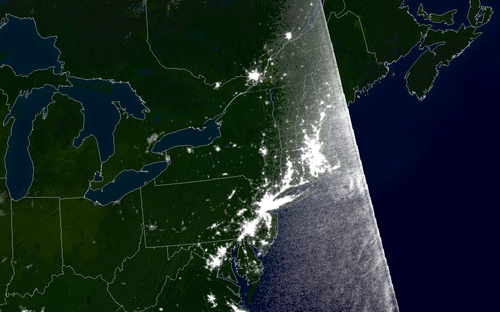It happened four years ago today: the largest blackout in North American history. To be honest, I don’t remember it, probably because it didn’t effect this region. But it effected 80 million people in eight states of the Northeast (including all of New York City), as well as 10 million in Ontario.
Wikipedia has a great entry on the event, including the post-partum of how it happened.
The official report blamed an Ohio electrical company’s failure to trim trees as the primary cause — specifically, a tree in Walton Hills, Ohio. But these things tend to have multiple contributing causes, and it ends up being a cascade of failures. Check out this timeline, again from Wikipedia — Even though it’s a few hours in the making, the shit hits the fan at 4:10 p.m. As each line fails, other lines are asked to do more work. Then those fail, and soon you have a cascading effect that plunges the Eastern seaboard into darkness.
- 12:15 p.m. Inaccurate data input renders a system monitoring tool in Ohio ineffective.
- 1:31 p.m. The Eastlake, Ohio generating plant shuts down. The plant is owned by FirstEnergy, a company that had experienced extensive recent maintenance problems, including a major nuclear-plant incident in 1985.
- 2:02 p.m. First 345-kV line in Ohio fails due to contact with a tree in Walton Hills, Ohio
- 2:14 p.m. An alarm system fails at FirstEnergy’s control room and is not repaired.
- 2:27 p.m. A second 345-kV line fails due to a tree.
- 3:05 p.m. A 345-kV transmission line fails in Parma, south of Cleveland, due to a tree.
- 3:17 p.m. Voltage dips temporarily on the Ohio portion of the grid. Controllers take no action, but power shifted by the first failure onto another 345-kV power line causes it to sag into a tree at 3:32 p.m., bringing it offline as well. While Mid West ISO and FirstEnergy controllers try to understand the failures, they fail to inform system controllers in nearby states.
- 3:39 p.m. A FirstEnergy 138-kV line fails.
- 3:41 and 3:46 p.m. Two breakers connecting FirstEnergy’s grid with American Electric Power are tripped as a 345-kV power line and 15 138-kV lines fail in northern Ohio. Later analysis suggests that this could have been the last possible chance to save the grid if controllers had cut off power to Cleveland at this time.
- 4:06 p.m. A sustained power surge on some Ohio lines begins an uncontrollable cascade after another 345-kV line fails.
- 4:09:02 p.m. Voltage sags deeply as Ohio draws 2 Gigawatts of power from Michigan.
- 4:10:34 p.m. Many transmission lines trip out, first in Michigan and then in Ohio, blocking the eastward flow of power. Generators go down, creating a huge power deficit. In seconds, power surges out of the east, tripping east coast generators to protect them, and the blackout is on.
- 4:10:37 p.m. The eastern Michigan grid disconnects from the western part of the state.
- 4:10:38 p.m. Cleveland separates from the Pennsylvania grid.
- 4:10:39 p.m. 3.7 GW power flows from the east through Ontario to southern Michigan and northern Ohio, more than ten times larger than the condition 30 seconds earlier, causing a voltage drop across the system.
- 4:10:40 p.m. Flow flips to 2 GW eastward from Michigan through Ontario, then flips westward again in a half second.
- 4:10:43 p.m. International connections begin failing.
- 4:10:45 p.m. Western Ontario separates from the east when the Wawa-Marathon 230kV line north of Lake Superior disconnects. The first Ontario plants go offline in response to the unstable system.
- 4:10:46 p.m. New York separates from the New England grid.
- 4:10:50 p.m. Ontario separates from the western New York grid.
- 4:11:57 p.m. The Keith-Waterman, Bunce Creek-Scott 230kV lines and the St. Clair-Lambton #1 and #2 345kV lines between Michigan and Ontario fail.
- 4:12:03 p.m. Windsor, Ontario and surrounding areas drop off the grid.
- 4:13 p.m. End of cascade. 256 power plants are off-line. 85% went offline after the grid separations occurred, most of them on automatic controls.
Satellite image of Northeast the day before the blackout:
Satellite image of Northeast during the blackout:
With the heatwave hitting the states right now, and the high energy consumption that goes with it, it’s kind of surprising that we haven’t experienced blackouts and brownouts like in years past. Maybe we learned something from four years ago….



